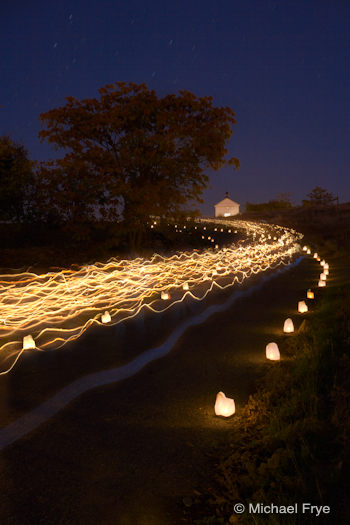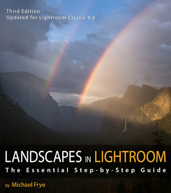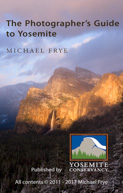by Michael Frye | Aug 28, 2014 | Night Photography
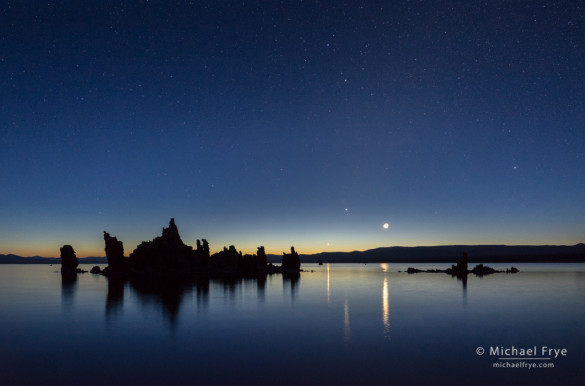
Venus, Jupiter, and the Moon rising at dawn, Mono Lake, Saturday morning
We had a wonderful time during our Starry Skies Adventure workshop last week. We managed to dodge the fires and had four clear, smoke-free nights. It was a really nice group, and photographing under a sky full of stars is always such a great experience.
One of the highlights of the workshop was viewing and photographing a dawn alignment of Venus, Jupiter, and the Moon over Mono Lake last Saturday. It’s hard to convey how gorgeous this was in a photograph, but you’ll find my best attempt above.
We also photographed star trails and the Milky Way, and went to Bodie on our last night. I’ll save the Bodie images for a later post, but you’ll find a selection of other images from the workshop below.
(more…)
by Michael Frye | Aug 14, 2014 | Night Photography
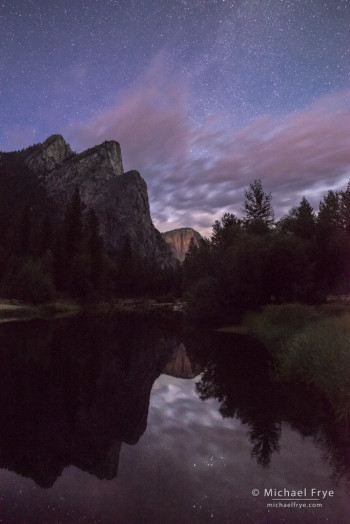
Stars and clouds over Three Brothers, Tuesday evening; 20 seconds, f/2.8, 6400 ISO
Tuesday evening Claudia and I drove to Yosemite Valley. The moon was due to rise about 90 minutes after sunset, so I hoped to photograph the northern end of the Milky Way over Three Brothers, with the rising moon adding a bit of light to the peaks.
We got to the Valley well before sunset, but there were some interesting clouds, so we decided to head to Tunnel View, where we found the usual August assortment of tour buses and people taking selfies in front of the panorama. I photographed some interesting patterns of dappled sunlight and clouds, then, just at sunset, after the crowds had thinned, the sky turned pink and a beautiful array of tufted clouds drifted overhead (below).
We had a little picnic along the Merced River as we waited for the sky to get dark, then I started taking photos of Three Brothers. At first the clouds blocked most of the stars. But the sky gradually cleared, revealing more stars, and then, looking at the photos on my camera’s LCD screen, I could see the clouds taking on a pink hue, and a hint of light on Yosemite Point in the distance. This was the lunar equivalent of a predawn glow, with the moon still below the horizon, but already adding some light and color to the scene. My eyes couldn’t see the color, but the camera could (right).
Later, as the moon rose for real, the clouds and peaks turned gold, just as they would at sunrise. Again, it was too dark for the cones in my retinas to pick up the color, but the camera recorded it perfectly. And some of the cloud formations were spectacular, fanning out in big V shapes above Three Brothers (below).
(more…)
by Michael Frye | Apr 17, 2014 | Night Photography
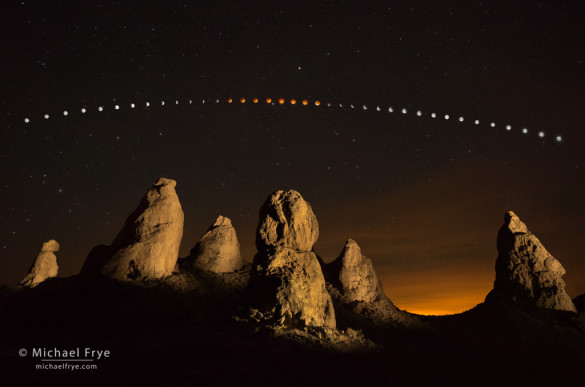
Lunar eclipse sequence, April 14th and 15th, Trona Pinnacles, CA, USA
Monday night’s lunar eclipse didn’t seem to line up well with any of Yosemite’s features, so I started looking for other locations – preferably someplace with clear, dark skies, and an interesting foreground. Death Valley came to mind, but then I thought of the Trona Pinnacles, near Ridgecrest. I’d never been there, but it seemed like an appropriately “lunar” landscape – so much so that the pinnacles have frequently been used to represent alien landscapes in sci-fi movies, including Star Trek V and Planet of the Apes.
Claudia and I drove down there on Monday and arrived about an hour before sunset. And what a great spot! I wondered why it had taken me so long to visit this striking landscape. The pinnacles are actually ancient tufa towers, like those at Mono Lake, left high and dry by the evaporation and shrinking of Searles Lake.
(more…)
by Michael Frye | Sep 27, 2012 | Advanced Techniques, Night Photography, Photography Tips
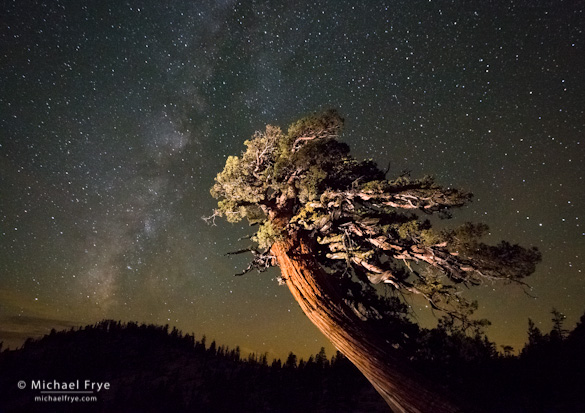
Sierra juniper and the Milky Way, Olmsted Point, Yosemite
Gear Doesn’t Matter—Except When it Does
Regular readers know that I’m not much of an equipment geek. It’s not that I don’t think equipment is important—a photographer needs good tools. It’s just that I think light, composition, technique, vision, and imagination are more important. In other words, how you use the tools is more important than what tools you use.
But sometimes the right gear can make a difference. Two weeks ago I was recording video segments for some online courses I’m working on (more about that later!), and needed a digital SLR that could record video—something my trusty old Canon 1Ds Mark II can’t do—for some “through-the-lens” views. So I called up my friend Jim Goldstein. Many of you know Jim through his popular blog and social media streams. Jim also works for Borrowlenses.com, and he set me up with a Canon 5D Mark III for my video shoot, and then asked, “Is there anything else you need?” Hmm… well I’ve been wanting to test the Canon 24mm f/1.4L lens for night photos, so yes, there was something else!
(more…)
by Michael Frye | Aug 7, 2011 | Advanced Techniques, Night Photography
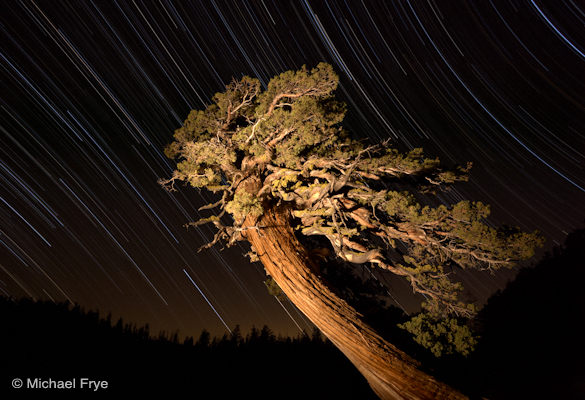
Juniper and star trails near Olmsted Point, Yosemite
Here’s a new image, made last Tuesday evening near Olmsted Point in Yosemite. My friend Mike Osborne calls this the “Bowsprit” tree. What? I didn’t get it either until he explained that a bowsprit is the bent figure with arms splayed back at the bow of old sailing ships. Okay, yeah, this does sort of resemble that.
Anyway, I “painted” this wonderful tree with a flashlight, and used the image-stacking technique to get noise-free star trails. With image stacking the idea is to take a series of short exposures and blend them together, rather than doing one long one. The total exposure time here is about 90 minutes, but one exposure that long would end up being quite noisy. Instead I took 24 four-minute exposures, with only a one-second interval between them. So each of those four-minute exposures has little noise.
(more…)
by Michael Frye | Nov 4, 2010 | Night Photography
Day of the Dead procession, Hornitos, California
Last year Claudia and I attended theDay of the Dead (All Soul’s Day) celebration in Hornitos for the first time. Hornitos is a tiny town in the Sierra foothills near my home in Mariposa. During the 1850s over 15,000 people lived there; now the residents number less than a hundred. But every November 2nd the town’s population swells, and several hundred people form a silent, candlelit procession from the town up a hill to the old church and graveyard, where they participate in a ceremony honoring the departed.
As I wrote last year, Claudia and I both found the ceremony moving and inspiring, and knew we had to return. Tuesday night we attended the event for the second time. We loved it, again; in our noisy world it’s wonderful to see hundreds of people holding candles and walking silently, solemnly through the night to an old graveyard. Although neither of us are practicing Catholics, we can appreciate rituals that help connect us with some of the more essential and elemental aspects of life and death.
About the Photograph
Last year I made some good images, but it’s difficult to photograph something like this when you’ve never seen it before, don’t know what to expect, and only have one chance at it. This time I had a plan. I positioned myself where I could see the curving line of the procession walking up the hill toward the church. With the camera locked on a tripod I made an exposure at dusk to capture some of the ambient light, then made a further series of long exposures as the procession passed by. The pieces were assembled in Photoshop. The squiggly lines were made by candles that people held as they walked up the hill. The blue streak is actually the viewing screen of a video camera dangling from a man’s shoulder as he walked up the hill—a nice touch of color, and the line helps fill in an otherwise empty space in the composition.
Some photographs are created spontaneously; others require planning. This is obviously an example of planning, as is my photograph of Horsetail Fall by moonlight. But most of my best images were made by simply reacting to what I saw around me—fleeting light or weather, or maybe just aninteresting arrangement of elements that could make a compelling composition. Planning and flexibility are both essential tools in a photographer’s kit.
Next November 2nd I may leave the camera at home and actually join the procession. Then again, I might not be able to resist trying to capture an event with such rich photographic potential. Either way, I’ll be there.






